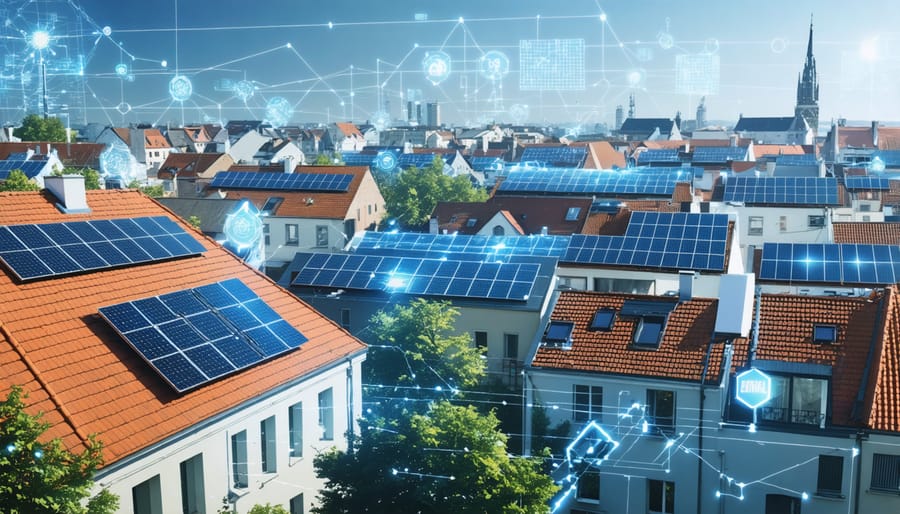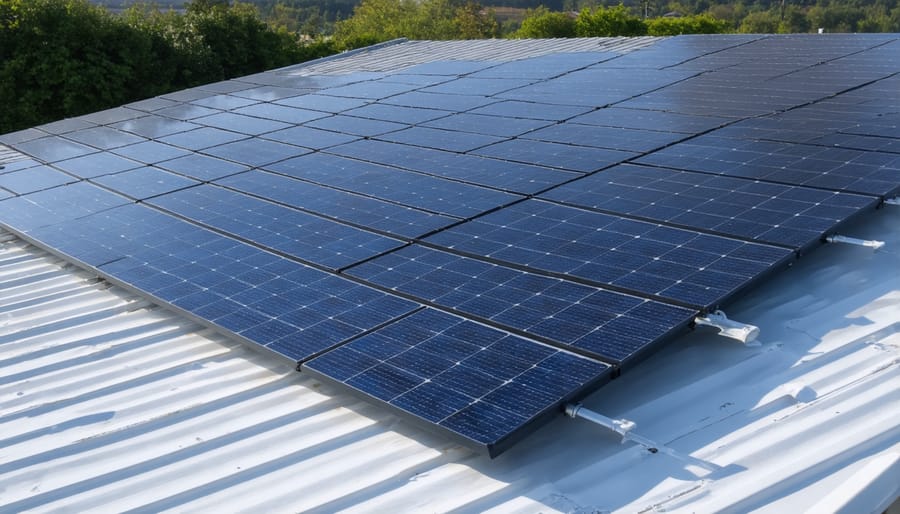Solar Energy Resilience: Your Power Security in an Unpredictable World

Energy resilience stands at the forefront of modern power infrastructure, representing our ability to anticipate, prepare for, and adapt to grid disruptions while maintaining critical operations. As Europe transitions towards renewable energy sources, the concept of energy resilience has evolved from simple backup power systems to sophisticated, integrated solutions that ensure continuous energy availability even during extreme circumstances.
In today’s interconnected world, where power interruptions can cascade into significant economic and social disruptions, energy resilience encompasses both technological and strategic approaches to power security. This includes smart grid systems, decentralized energy resources, and advanced storage solutions that work together to create robust, adaptive energy networks.
For European businesses and households, energy resilience means more than just keeping the lights on—it represents the capacity to maintain essential operations during power outages, adapt to changing energy markets, and contribute to a more sustainable future while ensuring economic stability and operational continuity.
What Makes Solar Energy Resilient?
Energy Independence and Local Generation
Energy independence through local generation represents a fundamental shift in how we approach power security. By installing solar systems, property owners can significantly reduce their reliance on traditional power grids, creating a robust buffer against external disruptions. This autonomy is particularly valuable in Europe, where grid stability faces increasing challenges from extreme weather events and growing energy demands.
Modern solar installations, combined with energy storage solutions, enable properties to generate, store, and manage their own power supply. The reliability of solar power systems has improved dramatically, offering consistent performance even during challenging conditions. This self-sufficiency helps protect against grid outages, price fluctuations, and supply chain disruptions.
Local generation also contributes to community resilience by reducing strain on centralized power infrastructure. During peak demand periods or emergencies, solar-equipped properties can operate independently, maintaining essential operations while supporting grid stability. This distributed approach to energy production creates a more flexible and adaptable power network, essential for future-proofing European energy systems against evolving challenges.

Weather-Resistant Innovation
Modern solar technology has evolved significantly to meet diverse environmental challenges, making it a cornerstone of energy resilience. Today’s solar panels incorporate advanced materials and engineering that enable them to perform reliably in various weather conditions. High-quality solar installations can withstand heavy rain, hail, snow loads, and extreme temperature fluctuations while maintaining consistent energy production.
European manufacturers have pioneered weather-resistant features such as reinforced glass surfaces, robust frame construction, and advanced sealing techniques that protect critical components from moisture and debris. These innovations ensure panels can operate effectively even in regions with challenging climates, from the Nordic countries’ snow-heavy winters to the Mediterranean’s intense summer heat.
The durability of modern solar systems is further enhanced by smart monitoring systems that detect and respond to environmental stresses. These systems can adjust panel orientation during storms, clear snow accumulation, and regulate temperature to optimize performance. With proper installation and maintenance, today’s solar infrastructure can maintain stable energy production for 25+ years, demonstrating remarkable resilience against weather-related challenges while supporting long-term energy security.
Key Technologies Driving Solar Resilience
Advanced Energy Storage Solutions
Modern energy storage technologies, particularly advanced battery systems, play a crucial role in strengthening energy resilience. These solutions have evolved significantly, offering increasingly sophisticated ways to store and manage power for both residential and commercial applications.
At the forefront of this evolution are lithium-ion batteries, which have become more efficient and cost-effective. These systems can store excess solar energy generated during peak production hours and release it when needed, ensuring a consistent power supply even during cloudy days or nighttime. In European markets, we’re seeing rapid adoption of smart battery systems that can automatically respond to grid conditions and energy demand patterns.
Beyond traditional batteries, innovative storage solutions are emerging. Flow batteries, which offer longer duration storage capabilities, are gaining traction for industrial applications. These systems can provide backup power for extended periods, making them particularly valuable for maintaining critical operations during prolonged grid disruptions.
Energy management systems (EMS) integrate seamlessly with modern storage solutions, optimising power distribution and usage. These intelligent systems can predict energy needs, manage storage levels, and automatically switch between different power sources to maintain uninterrupted supply.
For European businesses and homeowners, these advanced storage solutions represent a significant step toward energy independence and reliability. When combined with renewable energy sources, they create robust, resilient power systems capable of withstanding various external challenges while maintaining consistent energy supply.
Smart Grid Integration
Smart grid integration represents a significant advancement in energy resilience, combining sophisticated monitoring systems with automated control mechanisms to optimize power distribution. Through smart grid technologies, solar energy systems can dynamically respond to changing demand patterns, weather conditions, and grid stability requirements.
These intelligent systems utilize real-time data analytics to balance energy generation and consumption effectively. When solar production peaks during daylight hours, smart grids can automatically direct excess power to storage systems or redistribute it to areas with higher demand. During periods of low solar generation, the system intelligently manages stored energy reserves to maintain consistent power supply.
In European contexts, smart grid integration has proven particularly valuable for maintaining grid stability while accommodating increasing renewable energy penetration. Advanced monitoring systems can predict potential grid disturbances and automatically implement corrective measures, ensuring continuous power supply even during challenging conditions.
The integration also enables demand-response programs, where energy consumption patterns can be adjusted based on grid conditions and electricity prices. This flexibility allows businesses and homeowners to optimize their energy usage, reducing costs while contributing to overall grid stability. Through automated load management and predictive maintenance capabilities, smart grids significantly enhance the reliability and efficiency of solar energy systems, making them more resilient to external disruptions.

Implementing Solar Resilience in Europe
Residential Applications
For European homeowners, energy resilience takes on particular significance given the region’s increasing focus on sustainable living and energy independence. Modern residential energy resilience solutions typically center around a combination of solar panels, battery storage systems, and smart energy management technologies.
A resilient home energy system starts with properly sized solar installation, typically ranging from 3 to 10 kWp depending on household consumption patterns. This is complemented by battery storage systems, which have become increasingly affordable and efficient, allowing households to store excess solar energy for use during evenings or cloudy days.
Smart home energy management systems play a crucial role in optimising energy usage. These systems can automatically direct power to essential appliances during outages, manage consumption based on real-time electricity prices, and integrate with heat pumps and electric vehicle charging stations for maximum efficiency.
European homeowners can enhance their energy resilience through several practical measures:
– Installing hybrid inverters that can work with both solar panels and batteries
– Implementing smart monitoring systems to track energy production and consumption
– Setting up backup power circuits for critical household systems
– Investing in energy-efficient appliances to reduce overall power requirements
– Participating in local energy communities or virtual power plant programs
These solutions not only provide peace of mind during power disruptions but also contribute to reducing energy costs and carbon emissions while increasing property value.

Commercial and Industrial Implementation
Commercial and industrial facilities across Europe are increasingly implementing large-scale solar solutions as part of their business energy resilience strategies. These implementations typically combine extensive solar arrays with advanced energy storage systems and smart grid integration technologies.
Key components often include multi-megawatt solar installations on rooftops and adjacent land, coupled with industrial-scale battery storage systems. Modern facilities are incorporating sophisticated energy management systems that can seamlessly switch between grid power and on-site generation, ensuring continuous operations during grid disruptions.
Manufacturing plants, data centres, and logistics facilities are leading this transition, with many implementing microgrids that can operate independently when needed. These systems often feature advanced monitoring capabilities that predict potential disruptions and automatically adjust power distribution to maintain critical operations.
Innovation in this sector includes the integration of AI-powered predictive maintenance systems and dynamic load management. Many facilities are also implementing hybrid solutions that combine solar with other renewable sources, creating robust energy networks that can withstand various challenges.
Success stories across Europe demonstrate how industrial-scale solar resilience systems not only ensure operational continuity but also deliver significant cost savings and support sustainability goals. These implementations often serve as models for similar facilities looking to enhance their energy security while reducing their carbon footprint.
Energy resilience through solar power represents a crucial cornerstone of Europe’s sustainable energy future. As we’ve explored throughout this article, the ability to maintain reliable power supply despite external challenges is no longer optional but essential for both businesses and homeowners. The increasing frequency of extreme weather events, grid instability concerns, and energy security challenges make solar energy resilience a strategic imperative for European energy independence.
The evolution of solar technology, coupled with advanced energy storage solutions and smart grid integration, has created unprecedented opportunities for achieving true energy resilience. From microgrids serving entire communities to individual household installations, solar power systems are becoming increasingly sophisticated and reliable. This technological maturity, combined with declining costs and improving efficiency, positions solar energy as a key driver of Europe’s energy transformation.
Looking ahead, the future of energy resilience appears increasingly solar-powered. The European Union’s ambitious climate goals, coupled with national incentives and support programmes, are accelerating the adoption of resilient solar solutions across the continent. Innovations in battery technology, artificial intelligence-driven energy management systems, and advanced monitoring capabilities continue to enhance the reliability and effectiveness of solar installations.
For European stakeholders, investing in solar energy resilience means more than just ensuring continuous power supply – it represents a commitment to environmental sustainability, economic stability, and energy independence. As we move towards a more distributed and resilient energy system, solar power will play an increasingly vital role in ensuring that homes, businesses, and communities across Europe can maintain their operations regardless of external circumstances.
Success in this transition requires careful planning, expert implementation, and ongoing system optimization. The journey towards energy resilience may be complex, but the benefits of increased security, sustainability, and independence make it an essential investment in our shared future.
Leave a Reply